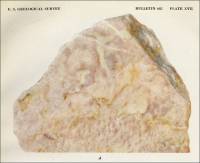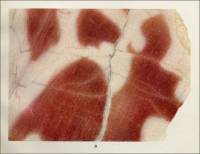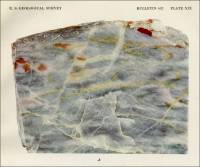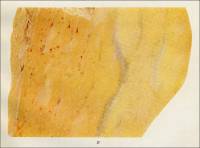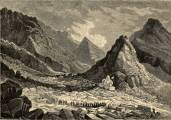
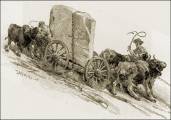

The Marble Deposits, By E. F. Burchard.
Analyses of marble from Orr Island
Insoluble matter (Dark veined) 3.50 – (Mottled) 2.95
Calcium carbonate (CaCO3) – (Dark veined) 95.99 – (Mottled) 95.35
Magnesium carbonate (MgCO3) – (Dark veined) 1.40 (Mottled) 2.04
“When visited in September, 1912, the quarry had been opened to a depth of about 11 feet only, and for the most part the surface rock had not yet been removed. Two drills and two channelers, both of the Ingersoll type, were in operation, and six or seven 10-ton blocks of marble from the second bench of the quarry were ready for shipment. The first consignment of blocks from this quarry reached San Francisco in February, 1913, and small shipments have been made in succeeding years. The quarry is equipped with hand power derricks capable of lifting blocks weighing 10 to 15 tons. The marble will have to be carried by scows from the quarry southward about 1 mile and transferred to freighters in deep water. Marble crops out at intervals for several hundred feet along a low bluff parallel to the beach and has been shown to underlie the whole group of claims, but its depth and soundness had not been demonstrated by the drill when the writer visited the locality in 1912. It is reported that openings have since been made about 500 feet farther north and that the rock found is very satisfactory in quality, but that the beds show considerable fracturing. In 1914 progress was reported in testing by means of core drills at an angle of about 45°. In one vertical drill hole good marble more or less fractured was found to a depth of 99 feet.
Heceta and Neighboring Islands.
“In order to verify several reported occurrences of marble on Heceta, Tuxekan, and smaller neighboring islands practically all the remaining shores of Sea Otter Sound and Davidson Inlet, as well as parts of Tuxekan Passage and Tonowek Bay, were examined. The calcareous rocks bordering these shores proved to be for the most part nonmetamorphosed limestone, principally of the gray or blue fine-grained brittle type, with fractures filled with calcite. Near the middle of the north side of Heceta Island (No. 36) is an exceptional limestone colored pink, red, chocolate, green, yellow, and white, with mottled effects. The stone is fine grained, hard, and dense and takes an excellent polish. (See Pl. XVII.) Some of it is conglomeratic. It has been somewhat fractured and recemented with calcite, but it is only slightly metamorphosed, and it yielded a few fossils, among which were recognized Conchidium sp., Capellinia sp., Trochonema sp., Heliolites sp., and a pentameroid (?). These forms, according to Edwin Kirk, are of late Silurian age. This limestone crops out at the head of a small bay and was traced southeastward on the strike for about 300 yards and to an altitude of 50 feet or more above high tide. In places the colors are much paler, but the mottled character persists, and much of the stone is attractively colored. An area of graywacke borders this limestone on the west and north. The rock is covered in most places by only a moderate thickness of moss and soil and supports the usual growth of brush and timber. Claims located on this mottled limestone by W. C. Waters are reported to have been sold to the Vermont Marble Co. in 1914. No marble was found on the smaller islands within this area – Cap, Hoot, Owl, Eagle, White Cliff, and Green islands.
Analysis of mottled limestone from Heceta Island.
Insoluble matter – 13.18
Calcium carbonate (CaCO3) – 84.46
Magnesium carbonate (MgCO3) – 2.85
“Samples of marble obtained near Waterfall Bay (No. 37), on the west coast of Dall Island, were shown to the writer at Ketchikan by M. D. Ickis in 1912 and found to be of much merit. The principal colors are white, pink, gray, and blue-black. The white and pink varieties are very handsome, the pink occurring in various delicate shades and in areas mottled with white. Some of the white marble is veined with yellow. Green marble is reported to occur but has not been much prospected. The white and pink varieties appear to have been wholly metamorphosed, but the gray and blue varieties appear to possess the characteristics of little-altered limestone. The grain of all the samples is fine, that of the gray and blue varieties exceedingly fine. In the lighter-colored varieties calcite crystals larger than the average are exceptionally present, but in general the texture is uniform, and thin pieces of the stone are as translucent as alabaster. This marble takes a very high polish. (See Pls. XVIII and XIX, A.)
“These marble deposits, which were not visited by the writer, lie about the head of Waterfall Bay, near the middle of the west coast of Dall Island. Twenty claims in all, aggregating 400 acres, have been located under the names Eurus, Marble Heart, St. Augustine, and Marble Bay groups. Openings are reported to have been made on a steep hillside about 300 feet above tide level and about 1,000 feet from the beach. Assessment work is said to have been done on these claims as late as 1915. A few dikes of ‘trap’ rock 1 foot to 4 feet wide are reported to cut the blue marble beds. The rock is probably much jointed, as many of the samples shown to the writer displayed one or more smooth joint faces. Blocks of the pink marble only 2 to 3 inches wide have been produced by parallel joints. It is said by interested parties the enough marble is available in these claims to warrant development and that several thousand dollars has been expended in prospecting, but emphasis should be given to the often repeated caution that the regional disturbances are likely to have badly shattered this marble.
“Theodore Chapin, of the United States Geological Survey, visited the Waterfall Bay region in the summer of 1915, and as a result of his observations contributes the following notes on the geologic relations of these marble beds.
“‘The geology of the region is simple. South of the bay the rock is limestone. The dominant color is blue to black, with lighter-colored areas where marmmarized (sic). Overlying the limestone with apparent conformity is schistose greenstone containing conglomerate beds, occupying the north shore of the bay. The contact extends about N. 75° E. from the cabin at the head of the bay. Both limestone and green beds stand nearly vertical but dip northwest at high angles except where overturned. The best marble noted occupies a belt of varying width along the greenstone contact. At one locality marble crops out to a measurable width of 400 feet, besides a considerable thickness of semicrystalline limestone. The marble has been exposed by surface stripping for several hundred feet from the head of the bay. At 300 feet from the cabin, at an altitude of 200 feet, the following section is exposed.
Section of marble on Waterfall Bay 300 feet from cabin.
(Headings: Greenstone – Feet.)
Bluish-gray marble crops out only at intervals – 300 (feet)
Blue and white mottled marble – 4 (feet)
Dike – ½ (foot)
Thin-bedded white marble with black specks and white mica – 4 (feet)
Pink-mottled white marble – 13 (feet)
Blue and white mottled marble, exposed – 25 (plus over minus symbol) (feet)
Base concealed.
“‘The best commercial marble in this section is the 13-foot bed of pink-mottled white marble. The upper and lower parts of the bed are even-textured, medium to fine grained white marble mottled with a very delicate pink tint and veined with irregular threadlike veinlets of yellow. In the central part of the bed the pink color is more pronounced and the rock contains much white mica, a combination that produces a handsome rock. A short distance beyond this locality the following section is exposed:
Section of marble on Waterfall Bay 600 feet from cabin, at an altitude of 400 feet.
(Headings: Schistose greenstone – Feet.)
Bluish-gray marble (in part mottled and veined with black) – 300 (feet)
Fine-grained white marble with brown veinlets carrying mica and pyrite – 26 (feet)
White marble with green patches and brown veinlets – 7 (feet)
Fine-grained white marble with brown and green veinlets carrying mica and pyrite, contains a few large crystals of calcite – 9 (feet)
White and pink marble with green areas – 11 (feet)
Fine-grained white marble with pyrite in tiny veinlets and disseminated in particles – 16 (feet)
Quartz schist containing pyrite – 1 (foot)
White marble, with pyrite and much chlorite in tiny stringers and veinlets – 10 (feet)
Dike – 2 (feet)
Concealed – 15 (feet
Blue limestone, with beds of white marble and schistose beds, grading downward into fossiliferous limestone.
“‘The white and pink marble with mottled-green areas is very handsome and susceptible of a high polish, except where the green minerals predominate. The greater part of the bed is white and pink marble, composed of nearly pure calcite of very thin grain, the individual minerals averaging about 0.05 millimeter in diameter. The base and top of the bed are variegated with green areas, which combined with the pink-mottled white rock, give a very striking effect. Under the microscope the green areas are seen to consist of sericite, quartz, and chlorite; the white and pink rock is essentially calcite. The great thickness of bluish-gray marble at the top of the measured sections contains beds of ornamental marble of commercial value. These beds are black and white, mottled in very intricate pattern, and bluish white with black veinlets. This rock takes a smooth polish.
“Marble crops out at several places along the south shore of the bay between the cabin and the greenstone contact. Near the cabin an opening has been made on a bed of fine-grained, even-textured white marble, carrying flakes of white mica. Another commercial marble on this bay is a fine-grained black variety that takes a good polish. The polished surface shows a black field with white-mottled areas and irregular veinlets of white calcite, which give it a pleasing appearance.
“Two specimens of the marble from Dall Island were examined by T. N. Dale and G. F. Loughlin. A section of the white variety was found to consist of plates of fine-grained twinned calcite in a matrix of extra-fine, untwined grains of calcite. The general texture of this marble resembles that of a marble from the Huntley quarry at Leicester Junction, Vt., which has an uneven parallel elongate texture with alternate irregular tiers of large and small grains,* called ‘flaser’ structure, but the marble from Dall Island is less regular. The twinned calcite plates range in diameter from 0.075 to 0.375 millimeter but mostly from 0.125 to 0.25 millimeter, and would be considered of medium grain. The grain diameter of the matrix material is fine, measuring from 0.009 to 0.037 millimeter. (See Pl. XVIII, B.)
(* Footnote 1, page 79: Dale, T. N., The commercial marbles of western Vermont: U. S. Geol. Survey Bull. 521, pp. 147-148, fig. 25, 1912.)
“The other specimen consisted of fine-grained, considerably fractured stone, having a gray groundmass containing a few irregular reddish mottlings and several white and yellow streaks along fracture planes, also some granular calcite filling former openings along fracture planes. The section showed an extra fine grained groundmass crossed by a band 0.66 millimeter wide, faulted transversely, consisting of calcite plates 0.094 to 0.56 millimeter in diameter. The groundmass shows a grain diameter ranging from 0.02 to 0.14 millimeter, but mostly from 0.037 to 0.076 millimeter. The estimated average diameter is 0.04 millimeter, and the grade is fine.
“An analysis of the white marble by R. K. Bailey gave the following percentages:
Analysis of white marble from deposit near Waterfall Bay, Dall Island.
Insoluble matter – 0.32
Calcium carbonate (CaCO3) – 99.59
Magnesium carbonate (MgCO3) – 1.03
Breezy Bay.
“In the autumn of 1914 and early in 1915 W. C. Waters examined the east shore of Dall Island and portions of Long Island and sent to the Survey samples of limestone and marble collected from several localities in these areas.
“Mr. Waters’s notes show two narrow areas of marble striking in a westerly direction from the northern part of Breezy Bay (No. 38) and an area of limestone a short distance to the south of the marble. The color of the sample of marble from Breezy Bay is uniformly light gray, and the texture is generally fine grained and dense as seen under a field lens. The rock is evidently composed mainly of calcium carbonate. The ledge is reported to be about 100 feet wide and to stand nearly vertical, with a west-southwest strike. So far as explored there was little cover besides moss over the ledge.
View Cove.
“Mr. Chapin also visited certain portions of the east coast of Dall Island. With regard to a deposit near View Cove (No. 39) he furnishes the following notes:
“‘Marble deposits occur on the east coast of Dall Island at a number of places. Near the head of View Cove a stream that enters from the southwest flows in a gorge following joint planes in the marble. This stream was traversed from the beach for half a mile and in that distance the bed strike about northwest, directly across the course of the stream, and stand nearly vertical. Most of the marble seen is pearl to gray in color and mottled and veined with white. At one locality occurs a 4-foot band of yellow marble with a green stripe, and bordering it is white marble mottled with yellow. The yellow marble takes a good polish and has a warm, soft tone. Associated with these beds is a little bluish-black marble. A polished specimen shows a black field variegated with dark-gray areas and tiny veinlets of white calcite.’
“Mr. Waters also reports that several colored varieties of marble occur here, including white, pearl, light with black veining, black, green, and yellow, and has sent samples of the pearl-colored, gray-veined, yellow, green, and black varieties to the Survey. The pearl-colored rock, in the hand sample, gives brisk effervescence with hydrochloric acid and is uniformly fine grained and dense, except for a few thin streaks of crystalline calcite. The color is not uniform but shows gradations from pearl to gray. A few small specks of pyrite were noted along a fracture plane. A thin section of this marble was examined by G. F. Loughlin, who reports that the material shown is nearly all even-grained calcite with a few large grains (single or aggregates) as much as 2 millimeters in diameter. The fine grains range from 0.01 to 0.3 millimeter in diameter and average about 0.08 millimeter. The grade of texture is therefore fine. A very few minute black grains, some certainly of pyrite, were noted; the largest was 0.035 millimeter in diameter. A few flakes of graphite may be included. The section also shows a very few grains of quartz 0.03 or 0.04 millimeter in diameter.
“The gray-veined material consists of medium-grained calcite with veins and spots of darker-gray finer-grained material showing close-folded structure. If large slabs of this marble could be obtained the effect, after polishing, would be very handsome.
“The black marble is bluish-black in the unpolished sample. It is a fine-grained, dense high-calcium limestone, possessing the color and density characteristic of rocks that are susceptible of high polish and that show a deep black color on polished surfaces. The rock is brittle and shows fine fractures recemented with calcite, and for this reason it is probably questionable whether large thin slabs could be prepared from it.
“The yellow sample (See Pl. XIX, B) is generally fine-grained, dense high-calcium marble. It takes a high polish, which brings out well the color, a warm light brownish yellow that resembles the yellow areas in the Italian Siena marble. This color in the hand sample, which is 3 ½ by 4 inches, is not uniform but becomes slightly lighter toward one edge. This is a very handsome marble, and if it can be obtained in large quantities and the conditions for quarrying and transportation are favorable, the deposit should prove to be very valuable.
“The green marble is also fine grained, and consists mostly of calcite but carries dark streaks of micaceous carbonaceous material with considerable pyrite. The general effect in the hand sample is grayish with clouded areas of grayish green, streaks of black, and here and there mottlings of light gray, giving altogether a very attractive appearance. The rock takes a high polish except along the black streaks, which consist of material harder than calcite.
“The marble in the vicinity of View Cove is all of the calcite variety.
Coco Harbor.
“Marble is reported to occur on the north shore and limestone on the south shore of Coco Harbor (No. 40). From W. C. Waters’s notes it is inferred that the beds strike west-northwest and dip south and that large dikes of ‘greenstone’ cut the beds at intervals of 30 to 40 feet, with small dikes between.
“Mr. Chapin also noted the marble on the northwest side of Coco Harbor half a mile from the head. He writes in regard to it:
“‘Where it crops out along the beach it is evidently faulted against gray limestone. Back from the beach the outcrops are too few to determine its relations accurately. The marble is white to gray. Much of it is very fine grained and pure white, and portions of it are coarsely crystalline with large flashing crystals of calcite. Pyrite is not abundant but was noted in places as veinlets and disseminated particles.’
“A sample of fine-grained white calcite marble was sent to the Survey from this locality by Mr. Waters. It appears to be of good white color but is a little soft and resembles the marble on the shore of Hood Bay, Admiralty Island (p. 54), examined by the writer. It is reported to contain so much iron oxide in places as to be of doubtful value. The ledge is said to be about 200 feet wide and to be covered mainly by 2 to 3 feet of earth, moss, and roots.
Baldy Bay.
“At High Point, on Baldy Bay (No. 41), marble was noted by Mr. Waters, who reports a ledge about 200 feet wide consisting of fine-grained white material, very much fractured on the surface. The ledge strikes west where noted, but the rocks in this locality are very much disturbed and dip and strike in many directions. Samples sent to the Survey are grayish to yellowish white and also bluish-gray medium-grained calcite marble containing in places grains of pyrite. The rock is of medium hardness. The marble beds are associated with slate.
Grace Harbor.
“A bed of white marble 6 or 8 to 20 feet wide having an easterly strike was noted by Mr. Waters half a mile south of the entrance to Grace Harbor (No. 42). Samples sent to the Survey are fine grained, dense, and very hard. The color is white, but some of the rock shows clouds of a faint brownish-yellow color.
American Bay.
“A deposit of schistose marble on the south side of American Bay (No. 43) is reported by Mr. Waters. The deposit is more than 500 yards wide, stands about vertical, strikes east, and is mostly covered by moss and timber. The marble is reported to be both fine and coarse grained and to contain mica, but no mention is made of its color, and although a sample as sent it did not reach Washington.
“Limestone and marble are also reported in the vicinity of Kaigani Harbor, but no descriptive details are available.
Cape Muzon.
“A bed of schistose marble 10 to 100 feet wide and 2 miles long ‘in the vicinity of Cape Muzon ’ is reported by Mr. Waters, who notes that the bed strikes west and stands nearly vertical. The material is reported to be white, pink, and green. A sample received by the Survey is of brownish-pink color, medium grain, and bright appearance. From notes on a chart sent by Mr. Waters it appears probable that this marble crops out west of McLeod Bay (No. 44).
Long Island.
“The northern part of Long Island appears to contain promising areas of marble. This part of the island is largely surfaced by calcareous rock. Theodore Chapin, who visited this locality in the summer of 1915, reports as follows:
“‘Deposits of marble have recently been located near the northwest end of Long Island, 3 to 4 miles north of Howkan, on two small bays known locally as Waters and Gotsongni bays. At this locality the brush is very thick along the shore and outcrops are few, making prospecting difficult, but physical conditions favor the exploitation of the deposits. The shore of the island rises abruptly from he beach, the timber is plentiful and of an exceptionally good grade, and the deposits occur on sheltered harbors which afford easy access to boats.
“On Waters Bay three claims, the Lily, Long Island, and White Cloud, have been located, and assessment work has been done. Most of the marble exposed has a bluish-white field with white-mottled areas and blue-black stripes. Under the microscope the rock is seen to be composed essentially of twinned calcite crystals ranging in size from 0.25 to 0.7 millimeter, inclosed in a network of finely granular calcite that averages about 0.05 millimeter and forms with the large calcite crystals an intersertal (sic) fabric. The large calcite crystals are bent and fractured. They are evidently crushed fragments around which the fine-grained calcite has recrystallized. The black stripes are composed of opaque particles of carbonaceous material, probably graphite. Associated with the striped marble are beds of medium-grained white marble of even texture and also beds of blue-clouded white marble with yellow patches. This rock takes an excellent polish.’
“The deposit at the head of Waters Bay (No. 45) is reported by Mr. Waters to strike northwest and to extend up both sides of a small stream for a distance of a mile, with a width of 2,000 feet. Samples of white, pearl-gray, gray-banded, and gray-veined marble from this locality were received at the office of the Geological Survey. The white marble is medium grained and shows faint pinkish-yellow tints. The hand sample is of granular texture, shows a bright, sparkling surface, and is translucent on thin edges. When struck it gives a clear ring.
“A thin section of the pearl-gray marble was examined by G. F. Loughlin. The material as seen under the microscope appears to be rather even-grained calcite, mostly twinned, with fine granulated borders. The grain diameters range from 0.08 to 0.7 millimeter and average between 0.20 and 0.25 millimeter, as the coarser grains predominate. The grade is, in general, medium. A few very fine oxidized pyrite grains scattered through the section were noted. The largest of these is only 0.04 or 0.05 millimeter in diameter. The section shows several minute limonite pseudomorphs after pyrite, also a few streaks of limonite, sufficient to give a pale-brown streak across a hand sample of the marble. A shear zone, containing rounded grains and a few very fine grains of quartz in a matrix of pulverized calcite, was noted. No quartz was seen elsewhere in the section. So far as the material in the thin section is concerned, oxidation is practically completed and no further staining from pyrite is likely. In fact, pyrite is so rare in the sample as to cause a negligible amount of staining.
“The banded marble is similar in texture to the white marble but has a light-gray body with the parallel straight thin bands of darker gray spaced one-eighth to one-half inch apart. The veined marble is similarly colored by less uniformly grained. The veins and clouded areas show attractive patterns produced by folding of the rock. It is reported that this deposit appears to be ‘solid’ – that is, comparatively free from fractures and joints.
“According to Messrs. Chapin and Waters there is at the northwest corner of Long Island, on the east side of Gotsongni Bay about three-quarters of a mile from the head of the bay (No. 46), an exposure of marble half a mile in length. The beds appear to strike north-northwest, or parallel with the axis of the bay. On the beach are outcrops of coarse-grained even-textured white marble by a brush-concealed strip in a large area of bluish-white to bluish-gray marble with black stripes. The rock is medium grained and even textured. It takes a good polish and is apparently free from quartz. White and pink varieties of marble are also reported to occur in this locality.
“A sample of the white marble sent to Washington by Mr. Waters is medium-grained calcitic material with a bright, sparkling surface where freshly broken. The rock possesses a high degree of translucence. A thin section of this marble was examined under the microscope by G. J. Loughlin. The material is composed of large irregular grains separated by a network of fine grains. This texture is due to granulation along the boundaries of the crystals and has been termed ‘flaser’ structure. (See p. 79.) The diameter of the interstitial grains is 0.02 to 0.10 millimeter with an average of about 0.04 millimeter. The coarser grains are 0.02. to 2.6 millimeters across and average about 0.06 millimeter. The average grain diameter of the marble, according to Mr. Chapin, is 0.25 millimeter. The only impurities noted by Mr. Loughlin were a cluster of pyrite (?) grains about 0.14 millimeter across and one very minute crystal of quartz (?).
“A sample of the pink marble consists of medium to coarse grained crystalline calcite, of a salmon-pink shade. The rock takes a good polish, and the polished surface brings out slight variations in the pink color and also several streaks of colorless calcite.
Southeastern Part of Prince of Wales Island.
Dolomi.
“Certain marble deposits on the east side of Prince of Wales Island in the vicinity of Dolomi were described by the Wrights,* as no new work was reported to have been done on the claims, they were not visited by the writer. The notes originally published are given below.
(* Footnote 1, page 85: Wright, F. E. and C. W. The Ketchikan and Wrangell mining districts, Alaska : U. S. Geol. Survey Bull. 347, pp. 196-197, 1908.)
“‘The properties of the American Coral Marble Co., are located at two localities – at the head of North Arm (47), where 12 claims have been located along the north shore of the inlet, and at the north entrance to Johnson Inlet (48, where the company has several claims extending from Dolomi eastward to Clarence Strait. The principal developments have been made at the North Arm property, and at this point a post office named Baldwin has been established. Active work at this locality began in 1904, and the marble deposits were prospected during that year. In 1905 a wharf was built, machinery installed, and buildings erected preparatory to quarrying the marble. During 1905, however, practically no work was done, and all of the machinery was removed in 1907. At the Dolomi property a small quarry was started on the hillside, at a point a quarter of a mile northeast of Dolomi post office and a few hundred feet from tidewater on the Clarence Strait side, and buildings were erected. No operations were in progress at these localities during 1907 [and none has been reported up to 1916].
“‘The deposits at North Arm and at Dolomi consist of marble beds interstratified with chloritic and calcareous schists, striking northwest with steep dips, usually southwest. The surrounding area is mantled by a dense growth of vegetation, and the limits of the deposits have not been definitely determined, though where the marble is exposed it is much fractured, variable in color and composition, and intersected by a few narrow dikes of diabase. The fracture planes were probably formed principally during the period of tilting and folding of the beds and existed before erosion exposed the present surface outcrops.
“‘Since that time weathering has accentuated and to some extent increased the number of fracture planes, and it seems probable, however, that in depth these numerous planes, although potentially present at lines of weakness, will become less numerous and will not interfere greatly in quarrying.
“‘Although some parts of the deposits consist of pure-white fine-grained marble of excellent quality, other parts are poorly colored, coarse grained, and of little commercial value, and it will probably be difficult to obtain large quantities of uniform grade. The better grade is reported to give the following analysis: Calcium carbonate, 94 per cent; alumina, 3.9 per cent; silica, 1.4 per cent; magnesia, 0.7 per cent. Pyrite is also present in small amounts, occurring in thin seams and finely disseminated in some of the marble.’
Commercial use of material within this site is strictly prohibited. It is not to be captured, reworked, and placed inside another web site ©. All rights reserved. Peggy B. and George (Pat) Perazzo.
